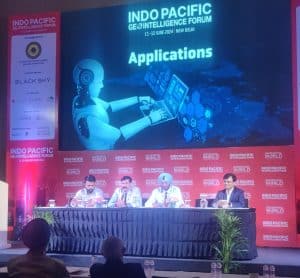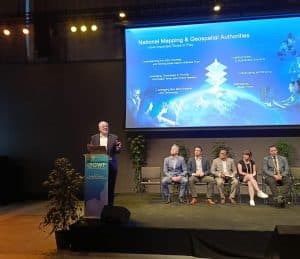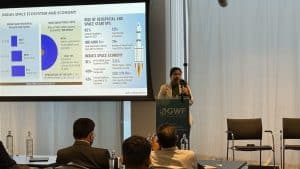A decade ago, discussion of Artificial Intelligence was predominantly found in science fiction, now it is easily accessible using Geographic Information Systems (GIS). The new buzzword is quantum, over the last few years it has hit news headlines and is being a large area of focus for companies like Google and IBM, with the UK Government investing millions of pounds in innovation projects for quantum since 2019.
The real question is, when will we see this technology be commercially available after all, it’s been almost 4 years since the first quantum positioning system (QPS) was demonstrated by Imperial College London.
Background
Quantum isn’t new, though its application is, they originally created it to explain phenomena which physicists couldn’t explain in earlier decades. The modern quantum theory began around the 1920s, most notably from the Bohr-Einstein debates which drew attention to something called quantum nonlocality, for pure bipartite quantum states that this is the same as quantum entanglement. Simply, the basis for quantum physics is where measurements of physical properties such as position, momentum, spin, and polarization may be performed on entangled particles and most times, be found to be the same.

Quantum theory wasn’t really considered for real-world applications until the release of Schrodingers Machines: The Quantum Technology Reshaping Everyday Life, written by Gerard J Milburn. In this, Milburn provides the term “Quantum Technology” and discusses the beginnings of how a quantum computer may work, also, the potential for unbreakable quantum cryptography. This was soon followed up in 2003 with Quantum Technology: The Second Quantum Revolution (also from Milburn) which provides more examples of technology that may be obtained from a quantum approach including projects that are currently exploring them.
These papers lead the way for the new quantum technology explosion which we are currently seeing. Many of the projects have grown from experimentation and application of the theory, so much so that from 2010 onwards multiple governments established programmes to explore quantum technologies.
In this piece we will primarily look at the two most influential areas of quantum which may affect the geospatial industry, these being Quantum Positioning Systems and Quantum Computing.
Quantum Computing
Quantum computing will change the way we use computers. A term we will all get used to hearing from large IT companies will be “Quantum Supremacy” which defines a computer that can solve a task faster than the fastest current non-quantum computer. This may come as a surprise to many, Google achieved quantum supremacy in October 2019. Let’s briefly discuss how a quantum computer works to understand why this may not be all it seems.
A standard computer works in binary, 1s and 0s, this is because it is built using millions of transistors which can only hold 2 different states; on or off. When information is parsed, this on or off-state is called a bit.
When you go on a website or even type a letter on the keyboard, your computer is just converting the 1s and 0s. Even with the most complex calculations, it is based on logic which can’t handle uncertainty well and doesn’t reflect reality as not everything is black or white.

Instead of bits, quantum computers use qubits. Qubits may be on or off, but also be in what’s called superposition, this is where they’re both on and off at the same time, (or somewhere on a spectrum between the two), this is where Scrodingers cat makes an appearance or doesn’t or both.
A qubit is a little like spinning a coin; it can be either heads, tails or if you stop it mid-spin, both. This element of uncertainty is what makes quantum computers so powerful compared to a standard computers.
If you tried to calculate your way out of a maze using a normal computer, the computer would look at each route to the exit individually until it found the optimal route. Whereas a quantum computer is able to look down each path all at once until it finds the solution. Another way to view this is that a standard computer works sequentially through the problem and a quantum computer can work through a tree of options until it comes to the optimal solution.
The other thing that qubits can do is called entanglement. If you flip two coins, the result of one coin toss has no bearing on the result of the other one. They’re independent. In entanglement, two particles are linked together, even if they’re physically separate. If one comes up heads, the other one will also be headed.
In quantum computing, this means you can move information around, even if it contains uncertainty and perform complex calculations using multiple qubits to tackle problems that would take our best computers millions of years to solve.
The applications for this are immense, it could revolutionise how we work with geospatial data, from rendering large point clouds, analysing big geospatial data or even analysing on a GIS. The biggest application is thought to be AI and GeoAI, where quantum computing is able to solve uncertainty models efficiently.
Quantum Positioning Systems
When a submarine dives, it has to record its position and then keep track of where it has moved to calculate where it may resurface, this may be up to 1km of its intended position as GPS radio signals cannot penetrate the water. This is why in 2014 the UK navy invested in a project with DSTL (Defence Science and Technology Laboratory).
The system works by supercooling atoms using lasers which once cooled, achieve a quantum state and can be tracked with another laser to measure the amount of force being exerted on them. It is extremely sensitive, however.
By 2018, Imperial College London, along with M Squared, demonstrated the first quantum compass.
Another method of positioning, which has recently entered its first use, is by using Optical Atomic Clocks, which are now small enough to be used on ships to navigate without GPS for up to 30 days.
DSTL, NPL (National Physics Laboratory) and Teledyne e2v, the commercial entity providing the solution, only a few months ago, in March 2022, announced that this technology would be used on the HMS Prince of Wales warship

This is an exciting technology with several other projects being developed around it whereby the UK military and US military are looking to move away from GPS in favour of optical atomic clock timing.
When will I get one?
Unfortunately, you may never get yourself a quantum computer, not that you could buy it off the shelf. First of all, they need to be kept super cool, then secondly they use quite a bit of electricity, the D Wave quantum computer consumes around 25kw of electricity in operation.
Of course, much like the mainframe computers of the 1970s and 1980s, the technology will reduce in size and become more useable and accessible, the bigger issue is that at the moment there is no aspiration to replace the standard computer, instead, they are used to solve quantum problems.
It is strongly believed that we will access quantum technology through QCaaS (Quantum Computing as a Service), this enables companies and users to lean on quantum computing when its needed. Gartner predicts that by 2023 20% of companies will be budgeting for QCaaS.
Artificial Intelligence and Machine Learning are already expected to accelerate through the growth of quantum computing, with faster-structured prediction, semi-supervised, unsupervised learning and improved perception all being within reach.
For geospatial, quantum will bring the ability to analyse data on a global scale, solving problems which are currently out of reach by getting insights on a global scale using QCaaS, much in the same way we currently do with local authority data. Will we see Esri adopt this technology into their suite? I wouldn’t put it past them.
Quantum Positioning will be a technology that will be the main growth area of interest in the geospatial world as there are many companies and government agencies eager to move from the fragile waves of GPS to something more resilient and less susceptible to spoofing.
In the years from 2014 – 2019, the DSTL QPS went from being a device that was 2 square meters to a box the size of a briefcase. Out in operation, companies like the European Space Agency (ESA) are looking at hybrid quantum positioning systems which are on the verge of being commercially available.
Over the next 5 years, we will see the commercialisation of the first hybrid QPS and in the next 10 years it will revolutionise the transportation industry and we will see more accurate subsea data being collected than ever before.

My personal thought on this is that QCaaS and QPS will need, in part, to grow hand in hand as we start to capture denser and larger data, especially when it comes to the subsea data. It will challenge our current geospatial software to develop capable big data 3D solutions.
Some technology predictions see a quantum navigation system which replaces GPS in place as soon as 2050.
Summary
It may be that we never own a quantum computer or a quantum positioning system on our phone in our lifetime, but what we will see, will be pretty cool, including the inaccessible areas of the earth being mapped.
An unbreakable positioning system that will allow ships, trains and planes to navigate without fear of GPS spoofing or blocking. Medical breakthroughs and global geospatial issues being solved using quantum computers, even hybrid quantum security on the internet, are all possible within the next decade.
If Gartner is correct, we need to be keeping a close eye on how quantum technology is evolving if it will be encroaching on budgets in the next year.
Disclaimer: Views Expressed are Author's Own. Geospatial World May or May Not Endorse it








